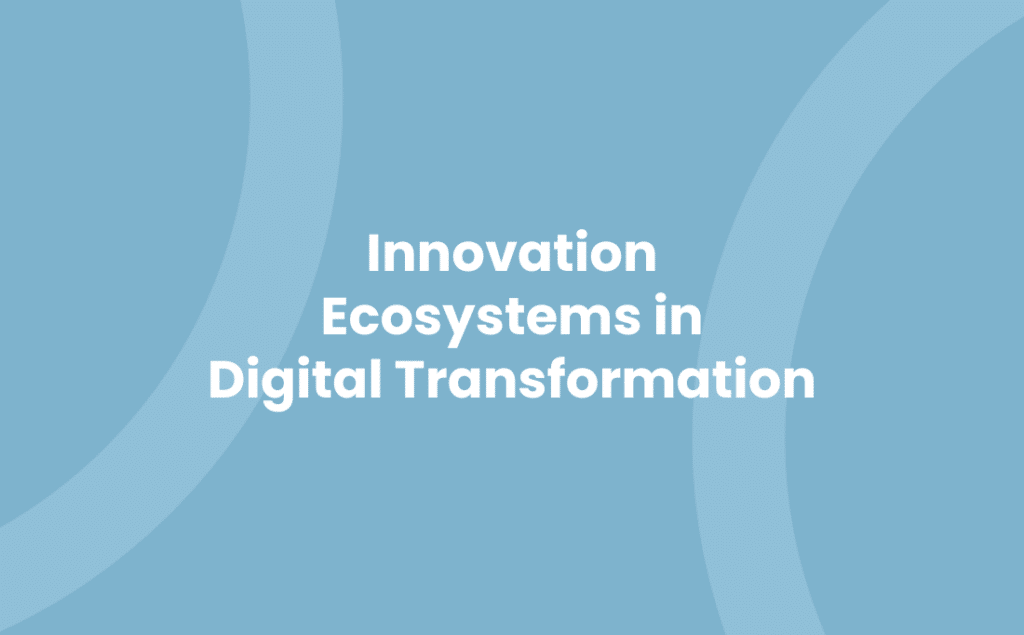Embarking on a digital transformation journey? You’re in the right place. In today’s fast-paced digital era, it’s vital to understand the role of innovation ecosystems in driving successful digital transformation. It’s not just about integrating new technologies into your business, but also about creating an environment that fosters innovation, collaboration and agility.
But what exactly are these innovation ecosystems and how do they contribute to digital transformation? That’s what we’re here to explore. We’ll delve into the world of digital ecosystems, shedding light on their importance and how they can revolutionise the way businesses operate. So, buckle up and get ready to navigate the digital landscape with a fresh perspective.
Understanding Digital Transformation
As your eyes traverse the realm of digital transformation, you’ll realise it’s not merely about integrating future-proof technologies. Imagine it as a digital ecosystem, where innovation is the lifeblood that fuels improvement.
This ecosystem represents digital transformation innovation ecosystems. They’re an exceptional blend of technology, processes, and humans ‚Äì all co-evolving. Standing, not only as a testament to technological advances, but as embodiments of strategic agility and adaptability.
You can hardly decipher digital transformation while excluding these digital ecosystems. They’re like conduits, connecting different facets of a business and weaving them into a unified digital fabric.
Diving deeper, these ecosystems promote collaboration. They’re bespoke designs enabling businesses to cross traditional boundaries and share knowledge. They are fostering competitive advantage, propelling SMEs in the UK and globally, towards unprecedented success.
Underneath the umbrella of digital transformation, these ecosystems pivot. They form the crux driving not just technological change but also shifts in business models and organisational culture.
However, demystifying digital transformation isn’t a walk in the park. It’s akin to navigating the high seas, with the need for a robust compass, meticulously charting your path through the ever-changing digital landscape.
In the heart of it all, you’ll find that digital transformation innovations ecosystems are designed to enhance. Enhance efficiency, increase productivity, and usher in a new era of business capabilities that are quintessential to thriving, not merely surviving, in the ever-evolving digital landscape.
So, when it comes to understanding digital transformation, bear in mind it’s not just about technology adoption. It’s about creating a dynamic and adaptive ecosystem, unlocking the secrets of not just surviving, but thriving in this digital age. For it is within these digital ecosystems that businesses find their pathway to sustainable digital transformation.
Remember, these innovation ecosystems form the backbone of digital transformation. That is why commitment to continuous innovation and collaboration sits at the epicentre of success in the digital world. It is through this commitment, that SMEs can gain the edge they need to compete in the digital race and secure future business success.
Exploring Innovation Ecosystems
Dive deeper into the sea of digital transformation innovation ecosystems. The concept, though intricate, boils down to a synergistic network that propels businesses into the future. The digital ecosystem gravitates around technology, processes, and human elements. Holistically, these aspects enhance efficiency, productivity, and overall business capabilities. They act as pivotal elements, fostering collaboration, breaking traditional boundaries, and sharing knowledge.
In the realm of digital transformation, innovation ecosystems ignite shifts in business models and organisational culture. Picture them as the switch, that when flipped, reveals the hidden treasures of modernisation. However, remember they’re not merely tech-centric. They prioritise creating an environment that nurtures innovative thinking and agility too.
Digital ecosystems act as lifeboats, enabling businesses to brave the storm of shifting technological advancements orderly. The symbiotic relationship within these ecosystems holds the secret to flourishing in the digital age. It’s a blend of agility, adaptability, collaboration, and innovation that unquestionably gives you a competitive edge. Here, dynamic and adaptive ecosystems exemplify powerful allies.
Maintain a commitment to continuous innovation within these ecosystems, however. It’s imperative to harness their full potential. Consider this the playbook for achieving future business prosperity. It elevates firms, especially SMEs, to thrive in the digital world. This strategy for nurturing innovation ecosystems ascertains a successful digital transformation.
Understand that digital transformation isn’t a task to tick-off. Instead, it’s a long, challenging voyage. One that requires a sturdy guide – your digital transformation innovation ecosystems. Create them strategically. Adapt them consistently. And most importantly, trust them entirely. It’s about sailing the turbulent seas of change, leveraging the winds of technology, and anchoring on the islands of innovation. Now, let’s cast-off into the generous ocean of digital transformation innovation ecosystems. You’re in safe waters now.
Elements of Digital Transformation Innovation Ecosystems
Three integral components make up digital transformation innovation ecosystems: technology, processes, and people. Let’s delve deeper into these elements, enabling an informed view of how they intertwine to drive rapid progression and evolution in the digital terrain.
- Technology: Tech innovations offer a broad range of possibilities. They form the foundation of your digital ecosystem, shaping business operations and customer interactions. For example, technologies like artificial intelligence (AI), machine learning (ML), and cloud computing provide opportunities for operational agility, data-driven decision making, and enhanced efficiency.
- Processes: Processes blaze the trail for effective harnessing of technological capabilities. They provide the blueprint that guides the practical implementation of tech solutions, effectively integrating them into everyday business operations. For instance, utilising data analytics involves establishing clear processes for data collection, analysis, and interpretation.
- People: At the core of the ecosystem sit the People – your team, partners, and clients. Empowered individuals, armed with the right skills and knowledge, help in merging technology and processes, bringing your digital transformation plans into reality. In such scenarios, consistent upskilling and open communication channels can result in a vibrant, adaptable corporate culture.
These components work in concert, nurturing a harmonious ecosystem that acts as a bedrock for continuous digital transformation. Proper integration, consistent investment, and effective management of these elements facilitate uninterrupted innovation. Consequently, your operation’s adaptivity gets enhanced, thus establishing your firm in a competitive position within the bustling digital landscape. Balance, foresight, and adaptation are key to maintaining this delicate trifecta of tech, process, and people, continually fuelling your progress amidst evolving digital demands.
Through this understanding, you’re better equipped to cultivate your digital transformation innovation ecosystem, pushing your business to the fore of digital progress.
Case Studies on Digital Transformation Innovation Ecosystems
Delve into practical examples offering deep insights into concrete implementations of digital transformation innovation ecosystems.
Firstly, consider the aviation industry, a sector that exemplifies the applicability of digital ecosystems. British Airways, for instance, invests heavily in digital enhancements, embracing AI and cloud computing. These technologies streamline operations, exemplifying the intertwining of technology and people. This continuous digital transformation fosters adaptation to volatile market conditions and changing customer behaviours.
Switching lanes, Starbucks serves as an epitome in the retail sector. The coffee giant integrates digital technology into its operations, unifying physical and digital customer experiences‚ known as ‘phygital’. Now, using their mobile application, customers place orders, pay, and collect rewards, augmenting customer interaction and satisfaction.
Additionally, British Telecom (BT) provides a compelling example within the telecommunications sector. BT underwent extensive digital transformation resulting in robust innovation ecosystems. The company developed ‘TechHub’ and ‘Innovation Martlesham’, supporting tech start-ups and fostering a culture of innovation.
You can glean from these case studies that regardless of the industry, successful integration of technology, processes, and people reaps significant benefits. It turbocharges customer interaction, enhances operational adaptability, and cultivates a culture of continuous innovation. With each innovation, digital transformation ecosystems evolve, fuelling the cycle of digital advancement.
These examples highlight the necessity of a flexible approach, adapting and adopting the dynamic digital environment. They underline that balancing and managing technology, people, and processes is pivotal for constant progression in the digital sphere.
Strategies to Implement and Sustain Innovation Ecosystems
Implementing and sustaining innovation ecosystems mandate strategic planning and consistent efforts. These innovation spheres aid a company’s digital transformation drive, fostering a culture of continuous improvement. Let’s explore some fundamental strategies:
- Adopt a Collaborative Approach: Collaboration, both internally and externally, is the bedrock of innovative ecosystems. This strategy primes innovation through idea exchange, shared resources and combined skill-sets. An excellent paradigm here is British Airways partnering with tech firms for its digital overhaul.
- Prioritise Upskilling: The people aspect of your ecosystem is crucial. Regularly invest in training employees in emerging technologies and adaptive operational processes. This investment promotes technical know-how and a pro-innovation mindset.
- Instill a Culture of Innovation: Champion disruptive thinking at every administrative level. Employees close to your operations often bring valuable insights. Starbucks, for instance, attributes its digital success to a culture of innovation encouraged from the ground up.
- Use Agile Methodologies: Agility underpins the success of digital ecosystems by enabling swift reaction to industry trends and customer demands. Positive illustration here comes from British Telecom manifesting nimbleness in its network virtualisation initiative.
- Optimise Tech Investments: Master the art of leveraging your technological assets. Whether AI, cloud computing, or big data analytics, extraction of their full potential is paramount.
- Iterative Improvement: Innovation isn’t restricted to breakthrough moments. Often, it’s about making incremental enhancements in your processes or products.
- Monitor and Adjust: Measure your innovation ecosystem’s impact periodically. If necessary, recalibrate your strategies based on these outcomes.
This strategic outlook isn’t about a one-time project. It’s about creating a mechanism for sustained innovation, making your organisation adaptable, competitive, and primed for continual digital transformation. As you traverse this digital route, remember that perfect orchestration of technology, processes, and people indicates success in digital transformation innovation ecosystems.
Challenges and Solutions for Digital Transformation Innovation Ecosystems
Executing Digital Transformation Innovation Ecosystems imposes a unique set of trials, ranging from technological adaptation to maintaining stakeholder trust.
Challenge: Obsolete Technologies
Older technologies can impede the ease of integration into new digital ecosystems. Apart from creating redundancy, resilient legacy systems can bottleneck the swift flow of innovation ecosystems.
Solution: Technology Auditing and Modernisation
Audit tech resources on a regular basis to recognise obsolete technologies. Addition of modern tech applications, like Cloud services or AI tools, ensures streamlined operations, fostering your digital transformation journey optimally.
Challenge: Resistance to Change
Often, stakeholders resist alterations to ingrained processes. This reluctance can limit adaptability to new methodologies integral to digital ecosystems.
Solution: Education and Support
Conduct workshops and seminars to educate your stakeholders about the benefits of digital transformation innovation ecosystems. Providing dynamic support fosters a smooth transition, softening the impact of the change.
Challenge: Security Concerns
With newer technologies come novel security risks, rendering organisations vulnerable to cyber threats.
Solution: Strengthened Cybersecurity Measures
Invest in robust cybersecurity tools to uphold the integrity of your digital ecosystems. Regularly update security protocols, and train personnel in cybersecurity best practices.
Challenge: Inadequate Skills
Digital Transformation necessitates up-to-date technical skills. A deficiency can lead to inefficiency, restricting innovation prospects.
Solution: Regular Training and Upskilling
Implement training and upskilling programs to upgrade your team’s skillset. Leverage partnerships with digital skills training providers for resourceful knowledge pools.
Recognise that no innovation ecosystem is immune to challenges and adopt these solutions to enable your business to thrive in the digital era. Transform setbacks into stepping-stones with strategic problem-solving, and empower your organisation to exploit the full potential of digital transformation innovation ecosystems.
The Future of Digital Transformation and Innovation Ecosystems
As we move deeper into the era of digital proliferation, digital transformation innovation ecosystems pick up the pace for advancing existing business models. They’re gearing up to introduce radical shifts in the ways businesses operate.
First up, expect automation to take center stage. More than merely a tech buzzword, it’s set to redefine operational strategies. From streamlining business processes to making informed decisions, automation lifts the burden of mundane, manual tasks. In turn, this allows businesses to focus more on formulating strategic business decisions.
Next, artificial intelligence (AI) and machine learning (ML) are set to expand their influence in the digital domain. Surpassing the boundaries of predictive analytics, AI and ML are unlocking new doors towards improved customer experiences. For instance, chatbots, powered by AI, are elevating customer service by providing prompt responses and personalised interactions.
Let’s turn our attention to Big Data. As businesses produce massive volumes of data daily, the need for advanced data management mechanisms increases. Big Data is a significant driver in the digital landscape, facilitating profound insights for evidence-based decision making.
Furthermore, anticipate an elevated role of cyber-security measures within digital ecosystems. As digital transformations rise, they bring along an array of security threats. Hence, stricter cybersecurity protocols and advanced threat detection mechanisms gain priority.
The advent of 5G technology is another game-changer that’s poised to revolutionise business operations. With its significantly faster data speeds and lower latency, 5G brings forth opportunities for real-time communication and smooth remote operations, a must in today’s dispersed workforce world.
Finally, look at the evolving digital culture. People remain at the heart of digital transformation. Hence, businesses invest in fostering a digital-first mindset among employees, fostering agility and innovation in their work approaches.
Remember, digital transformation isn’t a one-off project, but a continual process. It evolves with changing business needs and technological advancements. So, in your journey through digital transformations and innovation ecosystems, expect change as the only constant, paving the path towards agile and responsive business models.
Conclusion
So, you’ve seen how innovation ecosystems play a pivotal role in digital transformation. It’s all about leveraging technology, refining processes, and empowering people. Overcoming challenges like outdated tech and skills gaps is crucial, and solutions such as tech auditing and upskilling are the way forward. As we look to the future, it’s clear that automation, AI, ML, Big Data, cybersecurity, 5G technology, and fostering a digital culture are the game-changers. Remember, digital transformation isn’t a one-time thing. It’s an ongoing journey of continual improvement. Stay agile, adapt to change, and you’ll build a business model that’s not only responsive but resilient in the face of the digital age.


